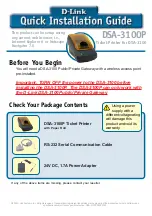
Image Quality
Copyright © 2010 BERTL Inc.
February 2010
All Rights Reserved. The license under which this document is made available and applicable law prohibit any reproduction or further transmission of any portion of this document. This
document may only be viewed electronically through the www.BERTL.com Web site and may not be stored in electronic or hard copy format. Any reproduction of trademarks is strictly
prohibited. BERTL accepts no responsibility for any inaccuracies or omissions contained in this document.
Page 12
February 2010
Copystar CS 520i
www.BERTL.com
IMAGE QUALITY
BERTL evaluates the output of several “test targets” in
order to determine image quality. Following are
descriptions of key elements of image quality. Note the
numbered examples on each of the test targets shown in
the right column.
Office Color Image Quality
1.
Density of Solid Areas -
Better contrast; more vivid overall images
2.
Line Work -
Better production of lines and text
3.
Halftones -
Better production of photographic and screened images
4.
Negative/Positive -
Better production of fine detail
Photographic Color Image Quality
5.
Flesh tones -
Better production of portraits
6.
Banding -
Better solid and dithered fill
7.
Low Contrast -
Better production of dark images
8.
Saturation -
Better production of bright colors
9.
Caste
– Better color fidelity
10.
Fine Detail
– Better reproduction of fine details
Density of Solid Areas*
Copy Density
Print Density
Black
1.27
1.32
*Density is on a scale of 0 to 2.5, with 2.5 being the best possible.
Copy & Print Resolution*
Copy Resolution
Print Resolution
Vertical
Horizontal
Vertical
Horizontal
Black
3.6
3.6
2.0
2.0
*Line Pairs per Millimeter. For copy resolution, higher is better (range,
2.0-8.0); for printer resolution, lower is better (range, 1.0-5.0).
Copy Halftones
Min. Gradation*
Max. Gradation**
Black
10
100
Print Halftones
Min. Gradation*
Max. Gradation**
Black
10
100
*Minimum gradation is on a scale of 10 – 100 percent in 10 percent
increments. The best possible minimum gradation is 10 percent.
**Maximum gradation is on a scale of 10 – 100 percent in 10 percent
increments. The best possible maximum gradation is 100 percent.
BERTL uses ImageExpert printer test targets for the evaluation of printed
image quality. BERTL technicians measure image density and evaluate
the device’s ability to produce a full range of halftones and various sizes
of negative/positive text, dots and lines in each primary printing color
(CYMK).
BERTL uses synthetic (photographic) test images obtained from
ISO
International Standard 12640--Graphic Technology—Prepress digital
data exchange—CYMK Standard Color Image Data (CYMK/SCID)
in
order to evaluate the ability to print photographic images.
1
1
1
1
2
3
4
5
5
5
1
6
7
8
9
10
10
10
10
10
10
8













































